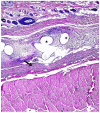The Effects of Pectin-Honey Hydrogel in a Contaminated Chronic Hernia Model in Rats
- PMID: 37888384
- PMCID: PMC10606599
- DOI: 10.3390/gels9100811
The Effects of Pectin-Honey Hydrogel in a Contaminated Chronic Hernia Model in Rats
Abstract
Incisional hernia is a frequent complication after abdominal surgery. A previous study on rats evaluated the use of a Pectin-Honey Hydrogel (PHH)-coated polypropylene (PP) mesh for the healing of acute hernias. However, there are no studies investigating the use of PHH in association with PP mesh in chronic contaminated hernia. The aims of this study are to assess the effectiveness of PHH in promoting abdominal hernia repaired with PP mesh and in counteracting infection. Twenty Sprague Dawley male rats were enrolled and a full thickness defect was made in the abdominal wall. The defect was repaired after 28 days using a PP mesh, and a culture medium (Tryptone Soy Broth, Oxoid) was spread onto the mesh to contaminate wounds in both groups. The rats were randomly assigned to a treated or untreated group. In the treated group, a PHH was applied on the mesh before skin closure. At euthanasia-14 days after surgery-macroscopical, microbiological and histopathological evaluations were performed, with a score attributed for signs of inflammation. An immunohistochemical investigation against COX-2 was also performed. Adhesions were more severe (p = 0.0014) and extended (p = 0.0021) in the untreated group. Bacteriological results were not significantly different between groups. Both groups showed moderate to severe values (score > 2) in terms of reparative and inflammatory reactions at histopathological levels. The use of PHH in association with PP mesh could reduce adhesion formation, extension and severity compared to PP mesh alone. No differences in terms of wound healing, contamination and grade of inflammation were reported between groups.
Keywords: adhesion; bacterial contamination; hernia healing; pectin–honey-hydrogel; polypropylene mesh; rats.
Conflict of interest statement
The authors declare no conflict of interest.
Figures










References
-
- Luijendijk R.W., Hop W.C., van den Tol M.P., de Lange D.C., Braaksma M.M., IJzermans J.N., Boelhouwer R.U., de Vries B.C., Salu M.K., Wereldsma J.C., et al. A comparison of suture repair with mesh repair for incisional hernia. N. Engl. J. Med. 2020;343:392–398. doi: 10.1056/NEJM200008103430603. - DOI - PubMed
LinkOut - more resources
Full Text Sources
Research Materials
Miscellaneous

